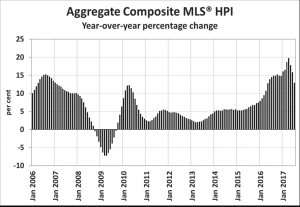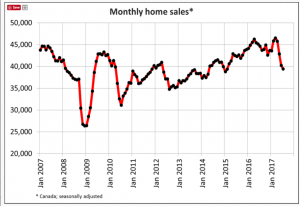Articles
Posted on August 15, 2017
Housing Market Weakens Further in July, But Drag From GTA Dissipates
 This morning’s release of the Canadian Real Estate Association (CREA) data for July confirmed that key housing markets in Canada continued to slow, led by the Greater Golden Horseshoe (GGH) region surrounding Toronto. This region’s marked slowdown began in late April with the announcement of a 15% foreign tax credit and a sixteen-point program to enhance housing affordability in the Ontario provincial budget.
This morning’s release of the Canadian Real Estate Association (CREA) data for July confirmed that key housing markets in Canada continued to slow, led by the Greater Golden Horseshoe (GGH) region surrounding Toronto. This region’s marked slowdown began in late April with the announcement of a 15% foreign tax credit and a sixteen-point program to enhance housing affordability in the Ontario provincial budget.
Notably impacting psychology, was the Bank of Canada rate hike in July, the first such hike in seven years. Positive surprises in the Canadian economy this year caused the Bank to preempt inflation pressures sooner than many had expected. The Canadian dollar and mortgage rates rose in response to the Bank’s action. The posted mortgage rate has now increased 20 basis points to 4.84%, which is of particular importance because this is now the assumed borrowing rate at which mortgage applicants must qualify for insured loans. There is a proposal to extend this qualification criterion to uninsured borrowers as well–that is, those that put at least 20% down on their home purchase. Before October 2016, the eligibility rate was the contract rate, which is meaningfully lower than 4.84%.
CREA’s national data showed that the number of homes sold on the MLS Systems fell 2.1% in July, the fourth consecutive monthly decline. While this decrease in sales was about one-third the magnitude of those in May and June, it leaves sales activity 15.3% lower than the record set in March. Sales were down from the previous month in close to two-thirds of all local markets, led by the Greater Toronto Area (GTA), Calgary, Halifax-Dartmouth and Ottawa.
On a year-over-year basis, sales were down 11.9% last month. Sales were down from year-ago levels in about 60% of all local markets. However, excluding the GGH region, net national sales activity was little changed from one year ago.
“July’s interest rate hike may have motivated some homebuyers with pre-approved mortgages to make an offer,” said CREA President Andrew Peck. “Even so, sales activity continued to soften in the Greater Golden Horseshoe region. Meanwhile, sales and prices in Montreal continue to strengthen.” Anecdotal reports suggest that foreign buyers were more active in Montreal where, in contrast to Toronto and Vancouver, there is no international buyers tax.
New Listings Slipped in July
The number of new listings edged down by 1.8% last month, led by the GTA. Many other markets in the Greater Golden Horseshoe region also saw new supply pull back after having surged immediately after the Ontario government housing policy changes in April 2017. New listings were also down in Calgary, Edmonton, Montreal and northern British Columbia, with the latter-most region hit by wildfires.
With sales down by about the same amount as new listings in July, the national sales-to-new listings ratio stabilized at a well-balanced 53.5%. By contrast, the ratio was in the high-60% range in the first quarter of 2017. The ratio in the range of 40%-to-60% is considered consistent with balanced housing market conditions. Above 60% is considered a sellers’ market and below 40%, a buyers’ market.
Based on a comparison of the sales-to-new listings ratio with its long-term average, more than 60% of all local markets are in balanced market territory. In the Greater Golden Horseshoe region, housing markets that recently favoured sellers for an extended period are now balanced, with some beginning to tilt toward buyers’ market territory.
Number of Months of Inventory
The number of months of inventory is another important measure of the equilibrium between housing supply and demand. It represents how long it would take to completely liquidate current inventories at the current rate of sales activity. There were 5.2 months of inventory on a national basis at the end of July 2017, the highest level since January 2016. The 5.2 figure was up from 5.0 months in June and up by more than a full month from where it stood in March.
The number of months of inventory in the Greater Golden Horseshoe region is up sharply from where it was before the April provincial announcements. For the region as a whole, there were 2.6 months of inventory in July 2017. While this remains below the long-term average of just over three months, it is more than triple the all-time low of 0.8 months reached in February and March.
Prices Continue to Decline
Home prices continued to fall in July, extending the decline that began in late April. The Aggregate Composite MLS House Price Index rose by 12.9% year-over-year in July, a further deceleration from the pace earlier this year. The decline in price growth from June to July was the result of softening prices in the GGH.
The MLS Home Price Index (MLS HPI) provides the best way of gauging price trends because average price trends are prone to be strongly distorted by changes in the mix of sales activity from one month to the next.
Price gains diminished in all benchmark categories, led by single family homes. Apartment units posted the largest y-o-y gains in July (+20%), followed by townhouse/row units (+15.9%), two-storey single family homes (+10.7%), and one-storey single family homes (+9.7%).
After having dipped in the second half of last year, benchmark home prices in the Lower Mainland of British Columbia have recovered and are now at new highs (Greater Vancouver: +8.7% y-o-y; Fraser Valley: +14.8% y-o-y).
Meanwhile, y-o-y benchmark home price increases were running a little below 20% in Victoria and just above 20% elsewhere on Vancouver Island.
Benchmark price gains slowed again on a y-o-y basis in Greater Toronto, Oakville-Milton and Guelph but remain well above year-ago levels (Greater Toronto: +18.1% y-o-y; Oakville-Milton: +12.7% y-o-y; Guelph: +23% y-o-y).
Calgary benchmark prices further edged into positive territory on a y-o-y basis in July (+1.1%). While Regina home prices popped back above year-ago levels (+3.6% y-o-y), Saskatoon home prices remained down (-2.2% y-o-y).
Benchmark home price growth accelerated in Ottawa (+5.8% overall, led by a 6.8% increase in two-storey single family home prices) and Greater Montreal (+4.9% overall, driven by a 7% increase in prices for townhouse/row units). Prices were up 5.4% overall in Greater Moncton, led by one-storey single family home prices which set a new record (+8.9%).

